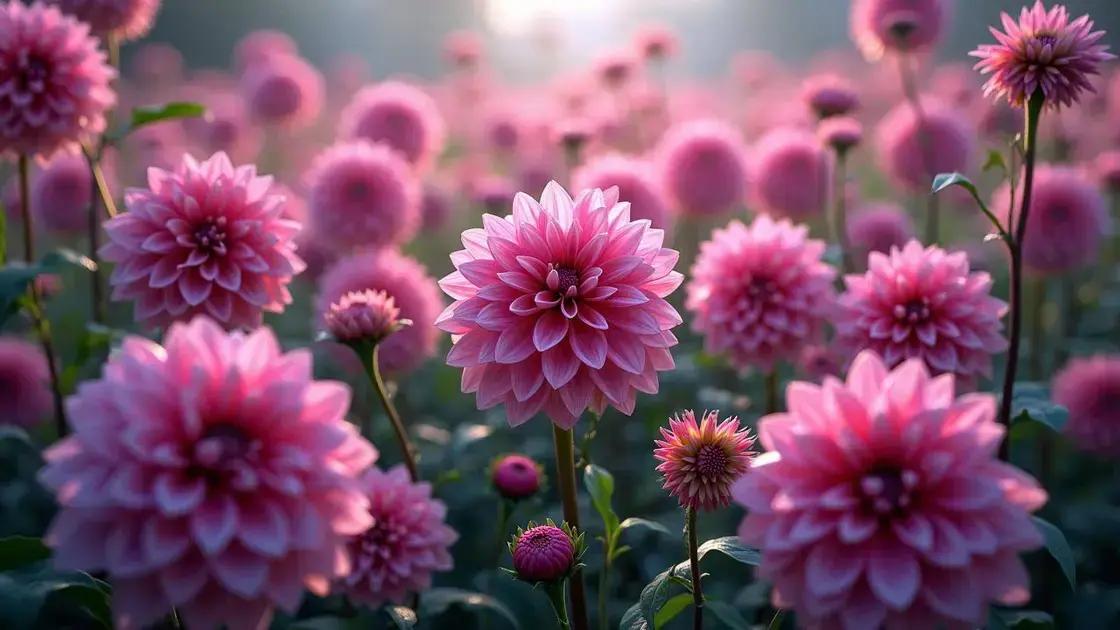How to Care for Dahlia Plants: 5 Essential Tips for Thriving Blooms
How to care for dahlia plants effectively can transform your garden into a vibrant display of color and life. With the right techniques, these stunning flowers can thrive and bring joy through the seasons. Unravel the secrets behind their care and watch your dahlias flourish with a few essential tips!
Table of Contents
ToggleWatering techniques for healthy dahlias
Watering techniques for healthy dahlias are crucial for ensuring these vibrant plants thrive and produce beautiful blooms. Proper watering not only supports growth but also helps prevent diseases and promotes strong root systems. In this section, we will explore effective watering practices to ensure your dahlias remain healthy and flourishing.
Understanding dahlia watering needs
Dahlias require consistent moisture, but overwatering can cause root rot, so it’s essential to find a balance. Here are some key tips for watering:
- Water deeply and less frequently to encourage strong root development.
- Monitor soil moisture by checking about an inch below the surface; if it feels dry, it’s time to water.
- Water in the morning to allow plants to absorb moisture before the heat of the day, reducing evaporation.
- Avoid wetting the leaves to decrease the risk of fungal diseases.
Seasonal watering adjustments
As the seasons change, so should your watering routine:
- Spring: Begin watering when new growth appears, typically every 5-7 days, depending on rainfall.
- Summer: Increase frequency to 2-3 times a week during hot, dry spells.
- Fall: Gradually reduce watering as temperatures drop and plants begin to die back.
Common mistakes to avoid
Ensuring the health of your dahlias can be as simple as avoiding a few common watering mistakes:
- Overwatering: Always check soil moisture before watering.
- Ignoring rainfall: Adjust your watering schedule based on weather conditions.
- Watering in the evening: This can lead to prolonged moisture on leaves, increasing disease risk.
For those interested in enhancing their gardening skills, consider exploring indoor gardening techniques to broaden your horticultural expertise.
Conclusion
By following the right watering techniques, you will not only help your dahlias flourish but also enjoy the stunning blooms they offer. Keep in mind their changing needs throughout the seasons to optimize their growth!
Soil composition and its impact on dahlia growth

Soil composition and its impact on dahlia growth play a pivotal role in allowing these beautiful plants to thrive. Healthy soil provides essential nutrients and a suitable environment for root development, which directly influences the vigor and bloom quality of dahlias. Let’s examine what makes the ideal soil for these flowering beauties.
Key components of ideal soil for dahlias
The best soil composition for growing dahlias includes a blend of various elements to support adequate drainage and nutrient retention:
- Loamy soil: A mixture of sand, silt, and clay that provides good drainage while retaining moisture.
- Organic matter: Compost or well-rotted manure enriches the soil with essential nutrients.
- pH level: Dahlias thrive in slightly acidic to neutral pH (6.0-7.0).
- Drainage: Ensure the soil is well-drained to prevent root rot, which dahlias are susceptible to.
How soil composition affects dahlia growth
Understanding the impact of soil components on dahlia health can help you create the ideal environment:
- Nutrient availability: Nutrient-rich soil supports vigorous growth, leading to larger flowers and lush foliage.
- Water retention: Proper soil composition retains moisture without becoming overly soggy.
- Soil aeration: Well-aerated soil fosters a healthy root system, encouraging strong dahlia plants.
Improving soil conditions for dahlias
Here are steps you can take to enhance your soil’s nutrient composition:
- Regularly add organic compost to the soil in the spring.
- Test soil pH and amend with lime or sulfur as needed.
- Incorporate mulch to retain moisture and suppress weeds.
For further insight into gardening practices, consider exploring indoor gardening techniques to expand your horticultural skills and knowledge.
Conclusion
By understanding soil composition and taking steps to optimize it, you can ensure that your dahlias grow healthily and reward you with stunning blooms throughout the season.
Sunlight needs and seasonal care for dahlias
Sunlight needs and seasonal care for dahlias are essential considerations for anyone looking to cultivate these vibrant flowers successfully. Understanding how much sunlight dahlias require throughout different seasons can significantly impact their growth and blooming potential. Let’s explore the sunlight requirements for dahlias and how to adjust care depending on the season.
Sunlight requirements for dahlia plants
Dahlias thrive best when they receive ample sunlight. Here’s a closer look at their sunlight preferences:
- Dahlias need at least 6-8 hours of direct sunlight each day for optimal growth.
- In hotter climates, providing light shade during the hottest part of the day can prevent wilting.
- Morning sun is ideal as it helps to dry dew off the leaves, reducing the risk of fungal issues.
Adjusting care with seasonal changes
As the seasons change, so should your care routine for dahlias:
- Spring: Plant dahlias after the last frost. Ensure they have ample sunlight as they start to grow. Regularly check soil moisture.
- Summer: Monitor water levels closely, watering deeply to help the plants cope with heat. Additional mulch can help retain moisture and keep roots cool.
- Fall: As temperatures drop, gradually reduce your watering frequency. It’s essential to keep an eye on the forecast for frost warnings.
Common challenges and solutions
Here are some potential challenges you might face based on sunlight exposure and seasonal shifts:
- Insufficient sunlight: If dahlias are not blooming well, they may not be getting enough sunlight; consider relocating them.
- Overexposure: In extreme heat, providing temporary shade can protect your dahlias from scorching.
- Fungal diseases: Ensure good air circulation and avoid overhead watering to prevent moisture stagnation.
If you’re interested in broadening your gardening knowledge, you might find value in exploring indoor gardening techniques that can also benefit your outdoor practices.
Conclusion
Attending to the sunlight needs and adapting your care to the changing seasons can lead to a flourishing dahlia garden, filled with beautiful blooms.
In conclusion
Caring for dahlias requires attention to various factors, including watering techniques, soil composition, sunlight needs, and seasonal care. By implementing the right practices, you can create an environment where your dahlias thrive and produce stunning blooms throughout the growing season. Remember, consistent care and adaptation to changing conditions are key to success in gardening. For those looking to expand their gardening knowledge further, consider these tips on enhancing your indoor garden as an excellent resource for improving your overall plant care techniques.

